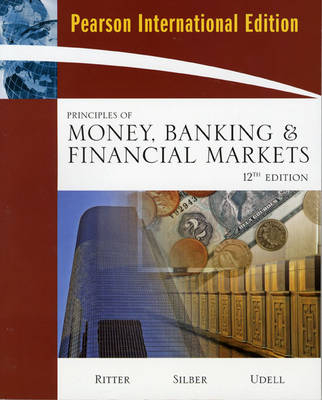
Principles of Money, Banking & Financial Markets
Pearson (Verlag)
978-0-321-50085-4 (ISBN)
- Titel erscheint in neuer Auflage
- Artikel merken
It is easy to encourage students to practice with MyEconLab, the online homework and tutorial system. New to the Twelfth Edition, select end-of-chapter exercises from the book are assignable in MyEconLab and preloaded problem sets allow students to practice even if the instructor has not logged in. For more information about how instructors can use MyEconLab, click here.
Lawrence S. Ritter (late) was Professor of Finance and Economics Emeritus at the Stern School of Business of New York University. A former Chief of the Domestic Research Division of the Federal Reserve Bank of New York, he served as a consultant to the U.S. Treasury, the Federal Deposit Insurance Corporation, the Board of Governors of the Federal Reserve System, the American Bankers Association, the Association of Reserve City Bankers, and the Garvin Guy Butler Corporation. He was an editor of the Journal of Finance and was a past President of the American Finance Association. Professor Ritter was also the author of numerous articles in professional journals and of The Glory of Their Times, a best-selling book about the early days of baseball. William L. Silber is the Marcus Nadler Professor of Finance and Economics and Director, Glucksman Institute for Research in Securities Markets at the Stern School of Business of New York University. A former Senior Staff Economist with the President’s Council of Economic Advisers and a former Senior Vice President at Lehman Brothers Kuhn Loeb, he has served as a consultant to the Board of Governors of the Federal Reserve System, the President’s Commission on Financial Structure and Regulation, the U.S. Senate Committee on the Budget, the House Committee on Banking and Financial Services, the Justice Department, the Federal Home Loan bank Board, the National Commission on Electronic Fund Transfers, and the Department of Housing and Urban Development. He is on the Economic Advisory Panel of the Federal Reserve Bank of New York and is the author of five books and numerous articles in professional journals. Gregory F. Udell is the Bank One Chair of Banking and Finance at the Kelley School of Business of Indiana University. He was formerly a banker and commercial loan officer in Chicago specializing in lending to small and midsized Midwestern companies. Currently, his academic research focuses on banking and financial contracting. He has published numerous articles in academic journals including the Journal of Political Economy, the Journal of Financial Economics, theJournal of Monetary Economics, and the Journal of Business. He is an associate editor of six journals, including the Journal of Money, Credit, and Banking, theJournal of Banking and Finance, and theJournal of Financial Services Research. Professor Udell has been a visiting economist and consultant to the Board of Governors of the Federal Reserve System.
Part I: The Basics
Chapter 1. Introducing Money, Banking, and Financial Markets
An Overview
Why Study Money, Banking, and Financial Markets?
Careers in Banking and Financial Markets
Chapter 2. The Role of Money in the Macroeconomy
Introducing Money
Money, the Economy, and Inflation
Chapter 3. Financial Instruments, Markets, and Institutions
Flow of Funds
Financial Instruments and Markets
Financial Intermediaries: Purposes and Profile
Part II: Financial Instruments and Markets
Chapter 4. Interest Rate Measurement and Behavior
Calculating Interest Rates
What Determines the Level of Interest Rates?
Chapter 5. The Term and Risk Structure of Interest Rates
The Term Structure of Rates and the Yield Curve
Risk and Tax Structure of Rates
Appendix: Bond Price Volatility: Duration Versus Maturity
Chapter 6. The Structure and Performance of Securities Markets
Nature and Function of Securities Markets
Efficiency of Secondary Market Trading
Efficient Capital Markets and Regulation
Chapter 7. The Pricing of Risky Financial Assets
Economic Uncertainty
Principles of Diversification
The Risk Premium on Risky Securities
Chapter 8. Money and Capital Markets
The Government Bond Market
Bank-Related Securities: CDs and Eurodollars
Corporate Securities
Municipal Securities
Mortgage Securities
The Stock Market
Chapter 9. Demystifying Derivatives
An Overview of Financial Futures
An Overview of Options Contracts
An Overview of Swaps
Chapter 10. Understanding Foreign Exchange
What Determines Foreign Exchange Rates?
Fixed Versus Floating Exchange Rates
Part III: Banks and Other Intermediaries
Chapter 11. The Nature of Financial Intermediation
The Economics of Financial Intermediation
The Evolution of Financial Intermediaries in the United States
Financial Intermediaries: Assets, Liabilities, and Management
Chapter 12. Depository Financial Institutions
The Fundamentals of Bank Management
Major Trends in Bank Management
Nonbank Depository Institutions–The Thrifts
Chapter 13. Nondepository Financial Institutions
Insurance Companies and Pension Funds
Mutual Funds
Finance Companies
Securities Brokers and Dealers and Investment Banks
Venture Capital Funds, Mezzanine Debt Funds, and Hedge Funds
Banks Versus Nondepository Institutions
Part IV: Financial System Architecture
Chapter 14. Understanding Financial Contracts
How Business Obtains Financing
The Economics of Financial Contracting
Chapter 15. The Regulation of Markets and Institutions
The Regulation of Financial Markets in the United States
The Regulation of Commercial Banks in the United States
Regulation of Nondepository Financial Intermediaries
Where Securities Market and Banking Regulation Meet: The Glass-Steagall Act, A Collapsing Barrier
Chapter 16. Financial System Design
Information and Financial System Design
Financial System Design: A Descriptive Summary of Germany, Japan, the United Kingdom, and the United States
Financial System Design and Conflict Resolution: Germany, Japan, the United Kingdom, and the United States
Financial System Design for Eastern Europe and Other Emerging Economies
Part V: The Art of Central Banking
Chapter 17. Who’s in Charge Here?
Formal Structure of the Federal Reserve System
The Realities of Power
The Problem of Federal Reserve Independence
Chapter 18. Bank Reserves and the Money Supply
Check Clearing and Collection
Deposit Expansion: The Single Bank
Deposit Expansion: The Banking System
Deposit Contraction
Appendix: The Complete Money Supply Process
Chapter 19. The Instruments of Central Banking
Reserve Requirements
Discounting and the Discount Rate
Open Market Operations
Chapter 20. Understanding Movements in Bank Reserves
The Fed’s Balance Sheet
The U.S. Treasury’s Monetary Accounts
The Bank Reserve Equation
Putting It All to Use
Appendix: Monetary Effects of Treasury Financing
Chapter 21. Monetary Policy Strategy
The FOMC Directive
The Fed’s Strategy
The Taylor Rule and the Fed’s Track Record
Part VI: Monetary Theory
Chapter 22. The Classical Foundations
Classical Economics
Aggregate Demand and Supply: A Summary
Real Versus Nominal Rates of Interest
Modern Modifications: Monetarists and New Classicists
Appendix: GDP Definitions and Relationships
Chapter 23. The Keynesian Framework
When Saving Doesn’t Equal Investment
Consumption and Simple GDP Determination
Government to the Rescue
Money and the Rate of Interest
Monetary Policy
Aggregate Demand and Supply
Chapter 24. The ISLM World
The LM Curve
The IS Curve
The Simultaneous Determination of Income and Interest: IS and LM Together
Monetary and Fiscal Policy
ISLM and Aggregate Demand
Appendix: The Simple Algebra of Income Determination
Chapter 25. Money and Economic Stability in the ISLM World
Monetary Policy, Fiscal Policy, and Crowing Out
Is the Private Sector Inherently Stable?
Flexible Prices, the Natural Rate of Interest, and Real Crowding Out
Appendix: Interest Rates Versus the Money Supply Under Uncertainty
Chapter 26. An Aggregate Supply and Demand Perspective on Money and Economic Stability
Is the Private Sector Inherently Stable?
Monetary Policy, Fiscal Policy, and Crowding Out
Inflation, Money, and the Phillips Curve
Inflation and Interest Rates
Should a Robot Replace the Federal Reserve?
Chapter 27. Rational Expectations: Theory and Policy Implications
When Are Expectations Rational?
Anticipated Versus Unanticipated Monetary Policy
Implications for Stabilization Policy
Inflation, the Phillips Curve, and Credibility
Interest Rates and Anticipated Monetary Policy
Chapter 28. Empirical Evidence on the Effectiveness of Monetary Policy
Living with Velocity
The Impact of Monetary Policy on GDP
Part VII: Grand Finale
Chapter 29. Tying It All Together
The Economic Indicators
Valuation, the Fed, and Market Reaction
Putting It All Together
Glossary
Index
| Erscheint lt. Verlag | 9.12.2008 |
|---|---|
| Sprache | englisch |
| Maße | 231 x 189 mm |
| Gewicht | 952 g |
| Themenwelt | Wirtschaft ► Betriebswirtschaft / Management ► Finanzierung |
| Betriebswirtschaft / Management ► Spezielle Betriebswirtschaftslehre ► Bankbetriebslehre | |
| ISBN-10 | 0-321-50085-7 / 0321500857 |
| ISBN-13 | 978-0-321-50085-4 / 9780321500854 |
| Zustand | Neuware |
| Informationen gemäß Produktsicherheitsverordnung (GPSR) | |
| Haben Sie eine Frage zum Produkt? |
aus dem Bereich



